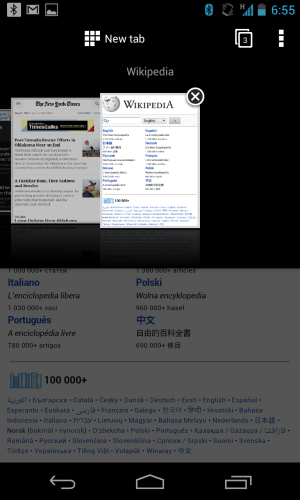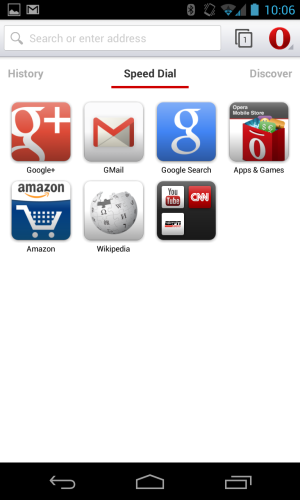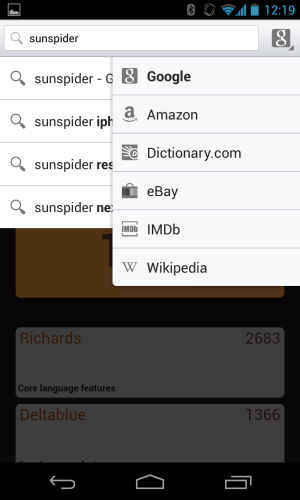Hands-on with the new mobile version of the world's fifth-favorite browser
New Opera for Android looks like Opera, tastes like Chrome
Hands-on with the new mobile version of the world's fifth-favorite browser.
Opera users on Android have been able to download a next-generation version of the browser in betafor some time, but today the company finally introduced those changes to the "stable" version of its mobile browser.
The new Opera comes with big changes both to its user interface and its engine. We'll start with the engine: this is the first version of Opera for Android to swap Opera's old rendering engine for one based on Chromium 26, the current stable version. In case you didn't know, Chromium is the open-source project from which Google Chrome draws the majority of its code, so both Opera and Chrome for Android should enjoy substantially similar performance and page rendering. For now, this means Opera has become based on Webkit, though the browser will make the jump to Google's new Blink engine when Blink becomes a part of Chromium's stable channel later this summer.
A quick look at a couple of JavaScript benchmarks confirm that the browsers now share rendering engines—in both Sunspider and Google Octane, both browsers score within the same range when run on the same hardware. Page loading times and scrolling performance seem more or less identical on my Nexus 4.
Now that the rendering engine is the same as Chrome's, Opera has to lean more heavily than ever on its user interface and feature add-ons to differentiate from its competitors. Yet at first blush, the new user interface shares quite a bit in common with Chrome. The address bar, new tab button, and settings button are all in the same place, though the way the browser arranges your tabs is different.
If you want to change things up, you can also move the browser's menu bar to the bottom of the screen in the settings. You might appreciate this if you have an especially large phone and have trouble stretching your thumb up to the top of the screen during one-handed use.

Your tabs are arranged in a Cover Flow-esque carousel rather than Chrome's stack of windows. Tapping the X dismisses the tab.

The Discover tab shows you top stories in a customizable list of categories. Tap the gear to toggle categories on or off.

The Speed Dial tab presents your frequently visited and bookmarked sites in a home screen-like customizable grid.
 |
First up, the Speed Dial page, which combines Chrome's frequently visited pages list with bookmarks that you add to the page yourself. The visual design of the page mirrors an iOS or Android-style home page—icons are arranged in a grid, and if you long-tap on one of them you can drag it over the top of another one to create folders full of icons. This idea actually works pretty well since users are already going to be familiar with how it works from their phones.
Swipe to the left and you'll see the Discover page, which will show you some "top stories" in a number of categories (which can be toggled in the menu). Swipe to the right to see your browser history, which is presented in an unembellished reverse-chronological list.
The new browser also includes an "off-road" mode intended for use with slow or intermittent data connections. It fetches pages through the Opera Mini servers, which compresses pages before sending them to your phone. The page rendering is decidedly worse—fonts, especially, don't render properly—but the included data meter told us we had only used about 20 percent of the data we would have used with the feature turned off. There may be situations where you'd be willing to sacrifice accuracy for bandwidth.
/ The same page, rendered more attractively by the default Chromium-flavored mode.
These aren't all of the features, but they're some of the most substantial. The browser also allows you to save individual pages for offline viewing; permanently enable a desktop user agent so that you never see the mobile versions of sites (Chrome only does this on a per-page basis); and adjust the quality of images downloaded in Off-Road mode to further cut bandwidth usage.

The browser doesn't yet support custom search providers, but you can choose from among the built-in providers by tapping the button to the right of the address bar as you type.
The new version of Opera for Android is available on the Google Play store for all Android smartphones running Android 2.3 or newer. If you're one of the unlucky third-or-so of Android users that has to get by with Gingerbread, this is your first opportunity to use the Chromium rendering engine (since Chrome for Android only supports Android versions 4.0 and newer). Tablet-toting Opera aficionados will still need to wait a bit longer—a tablet-ready version of the browser is in-work, but this version doesn't support Android tablets and was marked as incompatible with both my Nexus 7 and Nexus 10









0 comments: